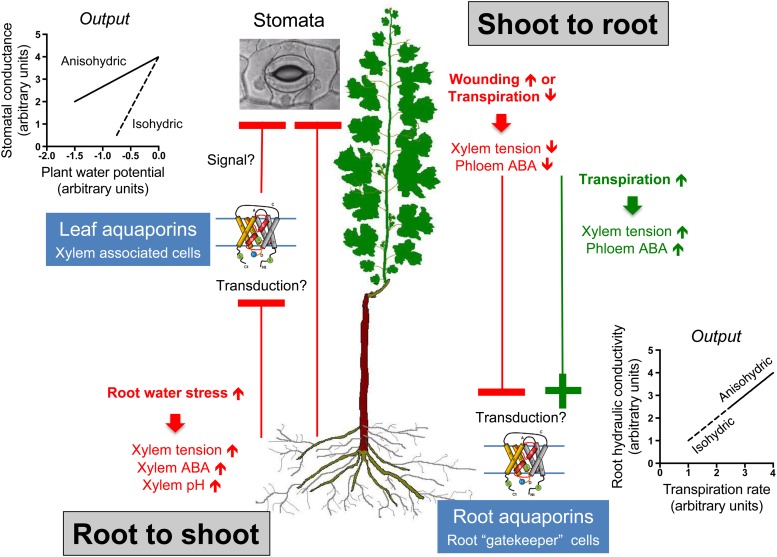Figure 2.
Long-distance signaling within plants involving aquaporins to coordinate water demand by the shoot with supply by the roots. On the left side is shown a summary of root-to-shoot signaling that occurs when roots are subjected to water stress. The classic ABA signaling pathway (including a coordinating effect of xylem sap pH; Wilkinson and Davies, 2002) is shown as a direct link to the stomata or through a hydraulic (pressure) signal that releases ABA in the shoot through an as yet unknown transduction process (Christmann et al., 2007). Also shown is an independent ABA signaling mode wherein bundle sheath cells and/or xylem parenchyma cells respond by reducing the activity of aquaporins (Shatil-Cohen et al., 2011; Pantin et al., 2013). This is proposed to convey a hydraulic signal to the stomata. The degree of isohydry/anisohydry (Output, top left) has been hypothesized to potentially reside in the gain of the ABA transduction process (Pantin et al., 2013). On the right side of the diagram is shoot-to-root signaling that appears to regulate Lpr in response to transpiration. The Output graph summarizes observations from various plants (Vandeleur et al., 2014). Increased transpiration increases root aquaporin expression and activity and Lpr (Levin et al., 2009; Sakurai-Ishikawa et al., 2011; Laur and Hacke, 2013), and the signal may be an increase in xylem tension that is rapidly transmitted to roots (McElrone et al., 2007); alternatively, phloem ABA may increase and stimulate root aquaporin activity (Kudoyarova et al., 2011). The method of signal transduction is unknown. Lowered transpiration leads to down-regulation of aquaporin activity and reduced Lpr possibly via release of xylem tension. Shoot wounding may interfere with this feedback system because similar aquaporin transcripts change in response to shoot decapitation, as in response to reduced transpiration (Sakurai-Ishikawa et al., 2011; Vandeleur et al., 2014). Isohydric and anisohydric plants appear to sit on the same linear response of Lpr versus transpiration (Vandeleur et al., 2009), suggesting that the degree of isohydry/anisohydry is more related to the response of the shoot to ABA, though this has not been explicitly tested.

